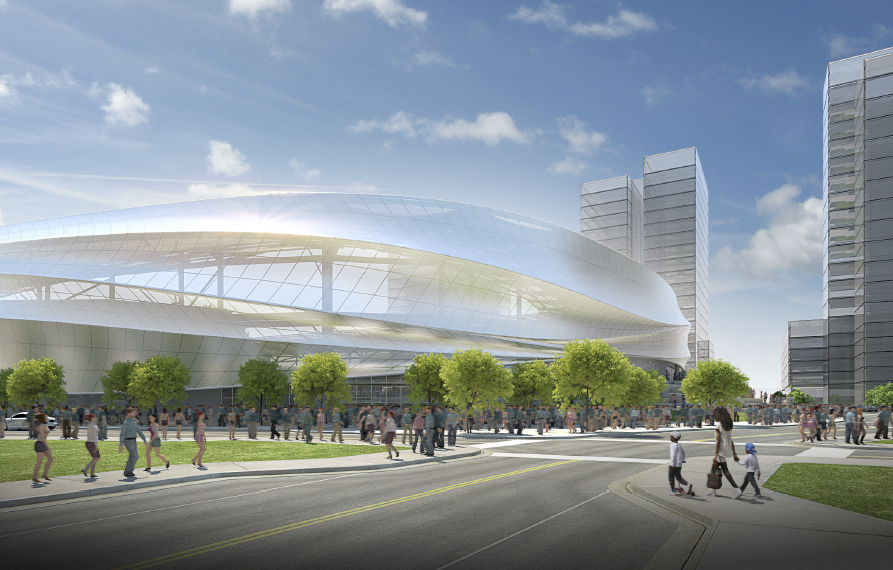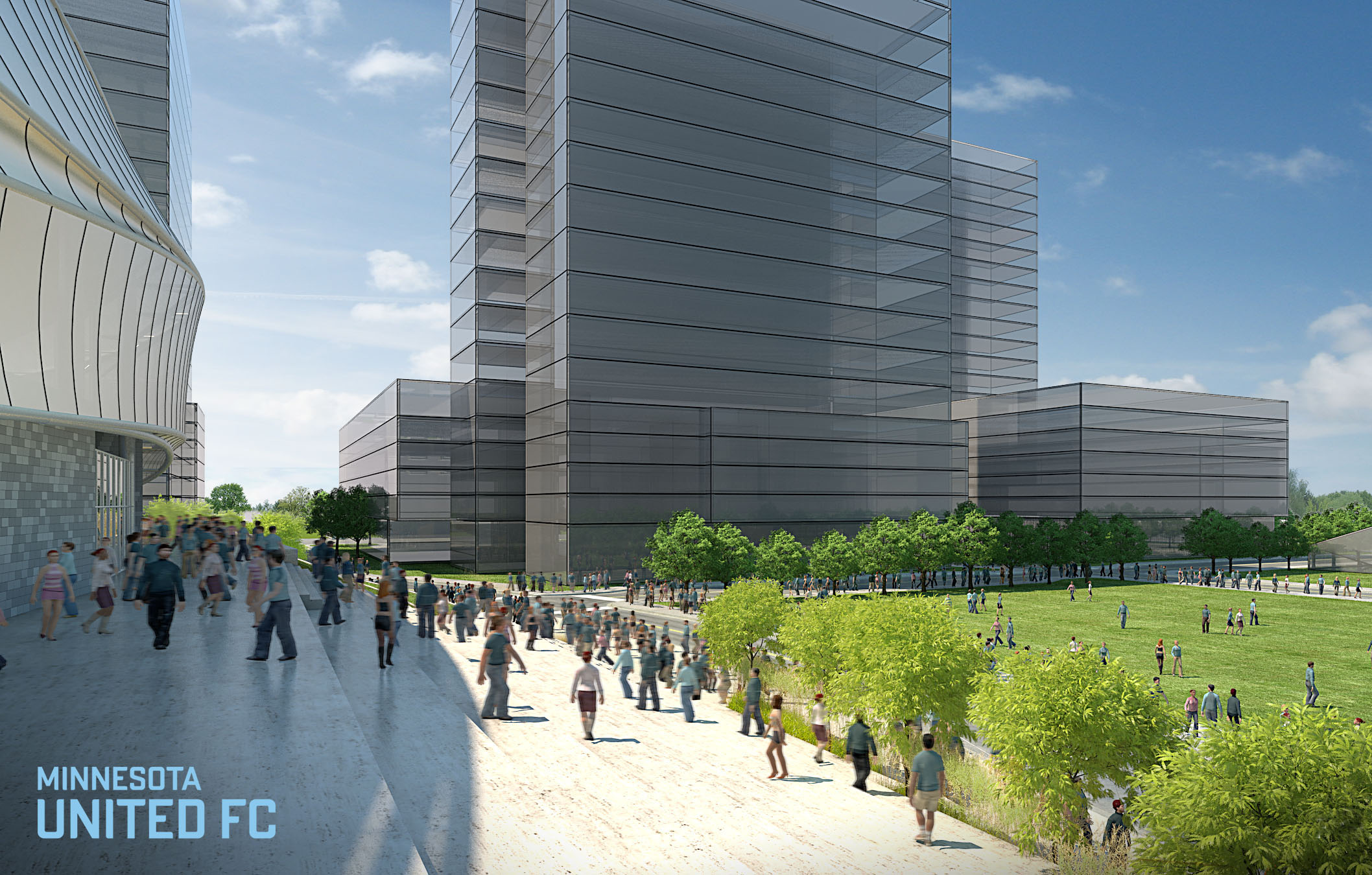FiftyFive.One has learned that the Midway Center ‘superblock’ is one of three locations in the running for building 400,000 to 700,000 square feet of office space for Prime Therapeutics Headquarters. The 34-acre superblock is where Minnesota United hope to build their new soccer stadium on the adjacent parcel of land known as the ‘bus barn’ site.
Minnesota United are still targeting the spring of 2018 to open their new soccer stadium despite delays caused by bipartisan legislative bickering. Team owner Bill McGuire has repeatedly said that he hopes and expects there will be plenty of future development on the site. One of the keystones of the Snelling and University superblock’s redevelopment is the northwest corner of that property, where developers hope a marquee tenant will build a hotel or corporate headquarters. That hope could be realized if Prime Therapeutics chooses the Midway Center for its new home office.
Prime Therapeutics is a privately owned company held by 13 different nonprofit Blue Cross and Blue Shield health plans. They are a third-party administrator (TPA) of prescription drug programs for commercial health plans called a pharmacy benefit manager or a PBM. In 2015 they were listed as the largest PBM in the United States. Prime Therapeutics created $3.5 billion in revenue in 2014 and currently employs more than 2,100 people.
Over the last 10 years, as their business has continued to grow and expand, Prime Therapeutics has been acquiring office space throughout the southern suburbs of the Twin Cities. The company is officially located in Eagan but many of the company’s executives work out of their Bloomington office, according to the Minneapolis St. Paul Business Journal.
Stadium Catalyst to Redevelopment
Multiple sources have told FiftyFive.One that Rick Birdoff and RK Midway have been in negotiations with Prime after the City of St. Paul and Minnesota United announced their intentions to build their new soccer stadium on the bus barn site. St. Paul Mayor Chris Coleman has repeatedly claimed that the Minnesota United stadium would be a catalyst to redevelopment of the run-down 1970s strip mall. In turn, the St. Paul City Council voted to spend $18 million on infrastructure improvements on both the bus barn site and Birdoff’s Midway Center to create a transit-oriented development (TOD) there. The TOD at Midway Center is a project that the City of St. Paul and the Met Council have been working on for years.
When asked about the the status of those negations, company spokesperson Marlene Kadlec said in an email, “Earlier this year, Prime, together with our real estate firm, JLL, sent requests for proposals to real estate brokers and developers in the Twin Cities. This was part of Prime’s long-term strategic real estate plan which includes finding ways to support potential future growth. We are still in the midst of that process and aren’t in a position to provide information about specific sites we may be considering.”
Prime Therapeutics would like to make a decision by the end of the year, according to Kadlec. They could also choose to defer building and continue to acquire real estate at different locations to fill their needs.
It is believed that the original images presented to the public by Minnesota United owner Bill McGuire and RK Midway owner Birdoff this spring were drawn up to show Prime Therapeutics what offices may look like at the Snelling and University location, tucked between public green space and the new United stadium. The images show several buildings that are 17 to 18 stories high. A build-out of 400,000 to 700,000 square feet would probably take several blocks and each building could be eight stories or higher. With a standard formula used by architects for square footage, a building of that size could employee 2,000 to 3,000 people.
One of the reasons Minnesota United picked the Midway site was its proximity to Metro Transit’s Green Line LRT, Snelling Avenue A Line BRT, and egress to I-94. Those same features would be benefits to a corporate headquarters.
Doubting the Demand of Midway
The news comes at a good time as many opponents of the stadium and redevelopment have been claiming that there is no concrete evidence of any sort of real redevelopment at the superblock. Redevelopment of this sort is usually done in what is called phased development and can often take years to become reality. Developers are also confined by non-disclosure agreements and are not allowed to talk about potential plans even though city residents often demand concrete proof of future development. That scenario played out this past Wednesday when the St. Paul City Council held a hearing on the Snelling-Midway master plan. Even Council Member Rebecca Noecker asked for evidence that businesses wanted to move into the area. The City Council will vote on the Snelling-Midway master plan as well as the stadium plan at their Aug. 17 meeting.
The master plan calls for minimum of 250,000 square feet of office space, 168,400 square feet of retail, and at least 248 residential units which some critics say is far too ambitious. “The office market is very thin in the midway area,” Birdoff said at Wednesday’s hearing. “It’s a difficult thing to say 100 percent you’re going to have 250,000 square feet.”
The building of office space for Prime Therapeutics at the site would be a huge boon to St. Paul and the blighted superblock site but Birdoff’s caution might be well advised, according to Lee Krueger, president of the St. Paul Port Authority. “I’m aware of it,” said Kruger when asked about Prime’s interest in the Midway area. “We’ve been asked to sit in at a couple of meetings because historically we have had certain financial incentives at our disposal such as New Market Tax Credits, which we don’t have right now. We were asked if we had an allocation. Right now we do not have an allocation. That’s where we were involved on it. We’re not intimately involved because the area they would be looking at would be the shopping center site. That is under someone else’s control.”
The New Markets Tax Credit (NMTC) is a federal program that was enacted as part of the Community Renewal Tax Relief Act of 2000. The goal is to help revitalization efforts of low-income and impoverished communities throughout the U.S. that might be overlooked for creating businesses and jobs. “Any time that a community can bring in a couple of thousand jobs it gets their attention,” said Krueger. The spin off is it has a multiplier effect: restaurants, dry cleaners, and barbershops want to be there.”
 Even if the NMTC incentives were found for Prime Therapeutics to build office space and bring in thousands of jobs to St. Paul’s Midway area, it could still be years before the buildings would be erected. Final plans for the office spaces wouldn’t happen until the company has picked a final destination. It would likely take eight to twelve months of designing and schematic work and then it would go through the lengthy process of getting city approvals and variances. In the end, two new office buildings in the Midway redevelopment site might not be finished until 2019 or 2020.
Even if the NMTC incentives were found for Prime Therapeutics to build office space and bring in thousands of jobs to St. Paul’s Midway area, it could still be years before the buildings would be erected. Final plans for the office spaces wouldn’t happen until the company has picked a final destination. It would likely take eight to twelve months of designing and schematic work and then it would go through the lengthy process of getting city approvals and variances. In the end, two new office buildings in the Midway redevelopment site might not be finished until 2019 or 2020.
Construction of Stadium and EPA Cleanup Start Dates
Construction and cleanup of the bus barn brownfield site could begin yet this fall, if the City Council passes the plans in mid-August and the State Legislature convenes for a special session around the same time to pass an omnibus bill that will include a tax exemption for the stadium. McGuire still maintains that he would like to have the stadium built by kickoff of the 2018 MLS season which starts in mid March. With all the delays that have pushed back construction, that deadline seems more than ambitious. It’s still believed that the stadium could be ready sometime during the spring or summer of that year.
The St. Paul Port Authority recently lobbied to get Minnesota’s Department of Employment and Economic Development to contribute $1.55 million to the environmental cleanup of the site. Monte Hilleman is the V.P. of Real Estate Development for the St. Paul Port Authority and says his group will be overseeing that project. “We would love to see a few months of activity yet this fall,” said Hilleman, who explained nothing will happen unless the city and state approve all measures.

“The first thing you have to do is earthwork and, in Minnesota, after October earthwork gets incrementally expensive. The moisture, the sunlight, frozen soil all adds to the expense.” Hilleman says that doing that sort of work in November and December is cost prohibitive but shouldn’t be presupposed. “It can be done but it all depends on the cost.”
Hilleman said he believes Mortenson Construction, the general contractor for the stadium, will be conducting the cleanup concurrently with construction phases of the project. “We are serving as environmental project manager and are really there to help with the cleanup. Mortenson will drive the schedule.” He said the general contractor will be on an accelerated timeline so the cleanup has to be done at the same time as construction.

Leave a Reply